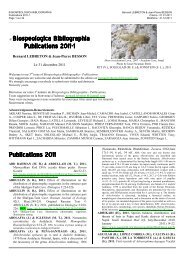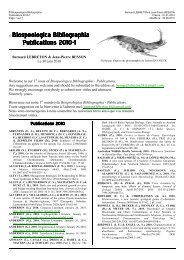Biospeologica Bibliographia Publications 2010-2
Biospeologica Bibliographia Publications 2010-2
Biospeologica Bibliographia Publications 2010-2
Create successful ePaper yourself
Turn your PDF publications into a flip-book with our unique Google optimized e-Paper software.
© <strong>Biospeologica</strong> <strong>Bibliographia</strong><br />
<strong>Publications</strong> <strong>2010</strong>-1<br />
Page 42 sur 116<br />
SMITH and Susan WHITE. BL: Cf p. 8, "Porndon Arch caves,<br />
where he gave due emphasis to the presence of the bats, and found that<br />
some settlers were using the guano as garden fertilizer"; p. 9, "Hamilton-<br />
Smith (1968, 1972) and Simpson & Smith (1964) studied the bat<br />
populations and the invertebrate fauna, primarily in Skipton Cave and<br />
some of the Byaduk Caves. There is also an interesting study of the<br />
ecology of Tunnel Cave by a group of students (Johnson & others,<br />
1968)"; p. 20, "The mining activities may have contributed to the<br />
disappearance of the large bat colony (reported by Robinson, and by<br />
Selwyn in 1875, but gone by the time the cave was visited by Fletcher in<br />
1895)". http://www.vulcanospeleology.org/symposia.html<br />
GRISMER (L. L.), SUMONTHA (M.), COTA (M.),<br />
GRISMER (J. L.), WOOD (P. L. Jr), PAUWELS (O. S.<br />
G.) & KUNYA (K.), <strong>2010</strong>. A revision and redescription<br />
of the rock gecko Cnemaspis siamensis (Taylor, 1925)<br />
(Squamata: Gekkonidae) from Peninsular Thailand with<br />
descriptions of seven new species. Zootaxa 2576(August<br />
25):1-55, 23 pl., 32 réf. ABS: A taxonomic revision of Cnemaspis<br />
siamensis (Smith, 1925) revealed it to be a complex composed of four<br />
species: C. siamensis (Smith, 1925) which occurs on Ko Tao Island, Surat<br />
Thani Province and on the peninsula ranges from Khao Mod, Surat Thani<br />
Province in the south, northward east of the Tenasserim Mountains to<br />
Kaeng Krachan National Park, Phetchaburi Province; C. chanardi sp.<br />
nov. ranging from Tai Rom Yen National Park, Surat Thani Province in<br />
the north, southward through the western foothills of the Nakhon Si<br />
Thammarat and Sankalakhiri Mountains to Phuphaphet Cave, Satun<br />
Province and westward to Khlong Thom District, Krabi Province; C.<br />
vandeventeri sp. nov. ranging from Kapur District, Ranong Province<br />
southward to at least Khlong Had Sompen, District, Ranong Province<br />
west of the Tenasserim and Phuket Mountains and possibly all the way to<br />
Phuket Island; and C. kamolnorranathi sp. nov. restricted to the<br />
northwestern section of the Itshmus of Kra, ranging from Tham Khao<br />
Sonk, Thachana District, Surat Thani Province southward to Tai Rom<br />
Yen National Park, Surat Thani Province. These species are easily<br />
separated from one another on the basis of their unique combination of<br />
having or lacking precloacal pores, dark gular markings, a series of<br />
lightly colored bars on the flanks, and a lightly colored, prescapular<br />
crescent as well as other aspects of squamation. Four additional new<br />
species from western and southern Thailand are also described: C.<br />
huaseesom sp. nov. from Sai Yok National Park, Kanchanaburi Province;<br />
C. punctatonuchalis sp. nov. from Thap Sakae District, Prachuap Khiri<br />
Khan Province; C. narathiwatensis sp. nov. ranging from Waeng District,<br />
Narathiwat Province south to Bang Lang, Yala Province; and C.<br />
niyomwanae sp. nov. from Thum Khao Ting, Palean District, Trang<br />
Province, Thailand. These species are differentiated from each other and<br />
all other Cnemaspis on the basis of their unique combinations of color<br />
pattern and squamation characters. This brings the total number of<br />
species of Cnemaspis in Thailand from five to 12 and continues to<br />
illustrate that the unrealized diversity in this group is a function of<br />
unfocused collecting efforts coupled with poor taxonomy. KW:<br />
Squamata, Gekkonidae, Cnemaspis, Thailand, new species.<br />
http://www.mapress.com/zootaxa/list/<strong>2010</strong>/2576.html<br />
GROL (B. P. F. E.) & VOÛTE (A. M.), <strong>2010</strong>. Hibernating<br />
bats in the Schenkgroeve, an artificial limestone cave in<br />
south Limburg, the Netherlands. Lutra 53(1):29-46.<br />
http://www.zoogdiervereniging.nl/node/1018<br />
Groupe Chiroptères Aquitaine (GCA), <strong>2010</strong>. Le Vallon du<br />
Cros… menacé par l'un des fuseaux de la LGV. Décembre<br />
2009 (Version actualisée le 18 Janvier <strong>2010</strong>), 12 p.<br />
Groupe herpétologique drômois & LPO Drôme, <strong>2010</strong>.<br />
Atlas préliminaire des Reptiles et des Amphibiens de la<br />
Drôme. ISBN: 978-2-9534797-1-3, Septembre <strong>2010</strong>, 107<br />
p. Voir: VINCENT (S.), <strong>2010</strong>. Pélodyte ponctué Pelodytes<br />
punctatus (Daudin, 1803):36-37.<br />
Groupe mammologique normand, <strong>2010</strong>. Plan Interrégional<br />
d'Action Chiroptères 2009-2013. Bilan 2009-<strong>2010</strong>. Haute-<br />
Normandie. 105 p., 8 Décembre <strong>2010</strong>.<br />
http://www.gmn.asso.fr/index.php?post/Un-nouveau-site<br />
GRÜNKE (S.), LICHTSCHLAG (A.), BEER (D. de),<br />
KUYPERS (M.), LÖSEKANN-BEHRENS (T.),<br />
RAMETTE (A.) & BOETIUS (A.), <strong>2010</strong>. Novel<br />
Bernard LEBRETON & Jean-Pierre BESSON<br />
Créé le : 01.01.<strong>2010</strong><br />
Modifié le : 30.06.<strong>2010</strong><br />
observations of Thiobacterium, a sulfur-storing<br />
Gammaproteobacterium producing gelatinous mats. The<br />
ISME Journal 4(March 11):1031-1043. DOI:<br />
http://dx.doi.org/10.1038/ismej.<strong>2010</strong>.23. ABS: The genus<br />
Thiobacterium includes uncultivated rod-shaped microbes containing<br />
several spherical grains of elemental sulfur and forming conspicuous<br />
gelatinous mats. Owing to the fragility of mats and cells, their 16S<br />
ribosomal RNA genes have not been phylogenetically classified. This<br />
study examined the occurrence of Thiobacterium mats in three different<br />
sulfidic marine habitats: a submerged whale bone, deep-water seafloor<br />
and a submarine cave. All three mats contained massive amounts of<br />
Thiobacterium cells and were highly enriched in sulfur. Microsensor<br />
measurements and other biogeochemistry data suggest chemoautotrophic<br />
growth of Thiobacterium. Sulfide and oxygen microprofiles confirmed<br />
the dependence of Thiobacterium on hydrogen sulfide as energy source.<br />
Fluorescence in situ hybridization indicated that Thiobacterium spp.<br />
belong to the Gammaproteobacteria, a class that harbors many matforming<br />
sulfide-oxidizing bacteria. Further phylogenetic characterization<br />
of the mats led to the discovery of an unexpected microbial diversity<br />
associated with Thiobacterium. KW: Gelatinous mats, microsensor, sulfur<br />
oxidizer, Thiobacterium.<br />
Grupo de Espeleología de Villacarrillo (G. E. V.), <strong>2010</strong>.<br />
Nueva Especie Cavernícola. En Acción 29:11. Revista de<br />
Voluntariado Ambiental. Consejería de Medio Ambiente<br />
de la Junta de Andalucía.<br />
GUADANUCCI (J. P. L.), BRAGA (P. L. M.), DE SOUZA<br />
SÁ (F.) & DA FONSECA FERREIRA (R.), <strong>2010</strong>. A<br />
troglophyle population of Diplura sp. (Araneae:<br />
Mygalomorphae: Dipluridae) in a quartzitic cave in<br />
Diamantina, Minas Gerais, Brazil:172. In: 18 th<br />
International Congress of Arachnology, University of<br />
Podlasie & International Society of Arachnology, Siedlce,<br />
Poland, 11-17 July <strong>2010</strong>, Book of Abstracts, editor: Marek<br />
ŻABKA, ISBN: 978-83-7051-575-1, 507 p. ABS: The cave<br />
Monte Cristo, located at 18°17.822'S, 43°33.511'W, is an approximately<br />
200 meters long quartizic formation. Hypogean environments house<br />
animals classified in three ecological-evolutionary categories according<br />
to their dependency on the cave: trogloxene, troglophyle and troglobite.<br />
During an inventory survey on cavernicolous arachnids in caves in<br />
Diamantina, state of Minas Gerais, several representatives of Diplura sp.<br />
were found. Considering the rarity of dense populations of<br />
Mygalomorphae spiders in caves, this finding led us to conduct a survey<br />
on the population dynamics of such species. Representatives of the genus<br />
Diplura are easily recognized by its mid-sized body, long posterior lateral<br />
spinnerets and presence of a maxillary lyra composed of few clavate<br />
setae. They build silky webs with tunnels with sheet web at the entrance,<br />
what makes them easily found. This work aims at studying this<br />
population and present data on the abundance of individuals, spatial<br />
distribution within the cave, territoriality, phenology and circadian<br />
rhythm. We have done three excursions from January to March of <strong>2010</strong>,<br />
when all webs with spiders were marked and numbered, and all spiders<br />
found were marked with coloured ink on the carapace. A total of 38<br />
individuals were marked, what makes it the largest mygalomorph<br />
population recorded inside a cave, 13 in the first trip, nine in the second<br />
and 16 in the third. Several spiderlings were found in the third excursion,<br />
indicating the end of the reproductive season, when all juveniles have<br />
already hatched and started to disperse and establish shelters in the<br />
habitat. Twenty four individuals were found close to the entrance, and the<br />
rest were at the aphotic region, where temperatures are lower and more<br />
constant and humidity is higher. We found no significant difference in the<br />
abundance of potential preys in the different regions of the cave, having<br />
no relation to spider distribution. Only one spider changed its web<br />
location during the observations and built a new shelter less than 1 meter<br />
away. Moreover, the number of old exuviae deep within the webs of<br />
many spiders found indicates that once the spider has established its web,<br />
it remains there for the rest of the life. Careful searches have been done in<br />
the surroundings of the cave and no representatives or webs of Diplura<br />
sp. were found, showing the clear preference for the cave environment.<br />
Several other animals are known to inhabit caves as troglophyles (e. g.<br />
bats, harvestman, pseudoscorpions, several insects), what shows the<br />
importance for the preservation of such environments. Monthly<br />
observations will be done during a year to evaluate aspects on the<br />
phenology and circadian rhythms of this population.





